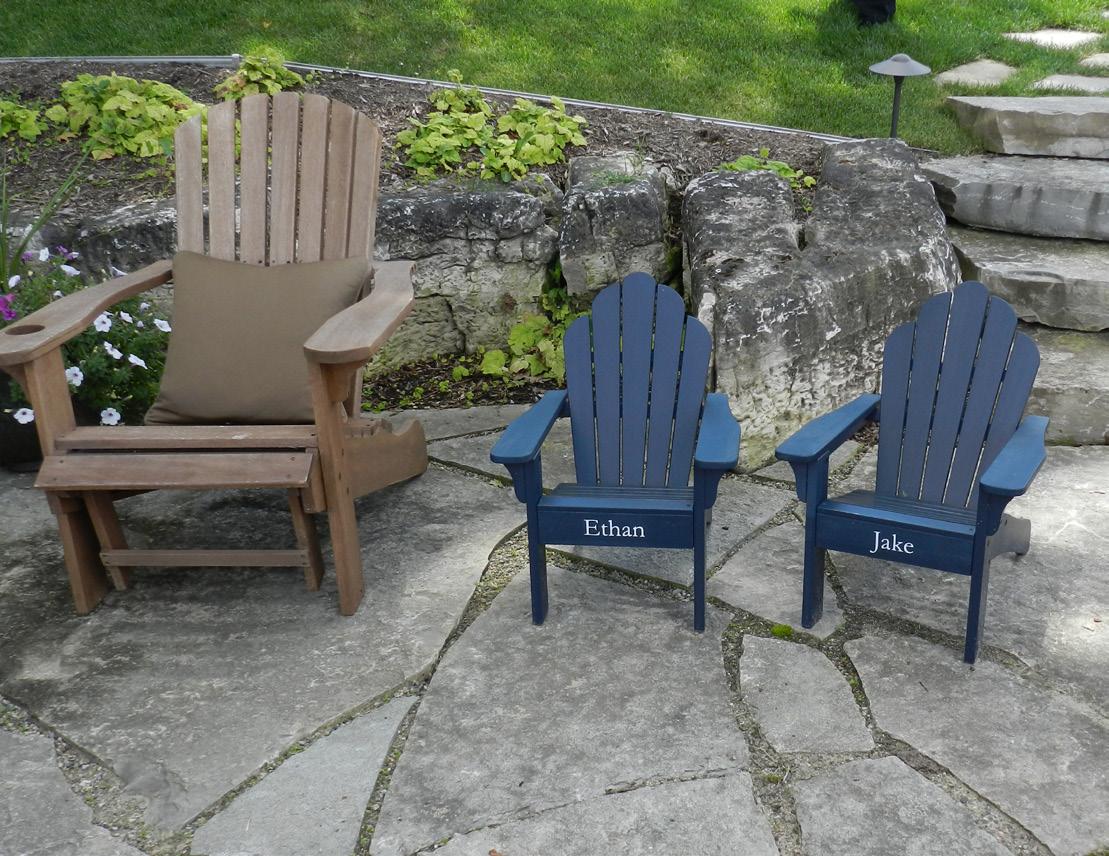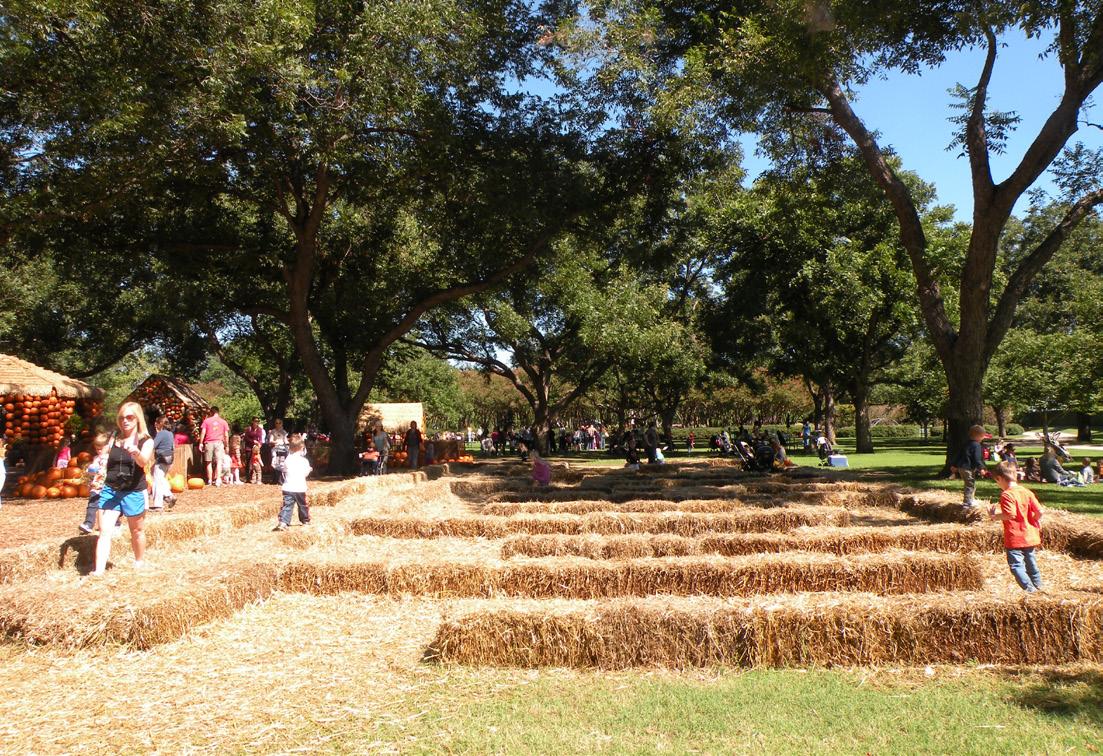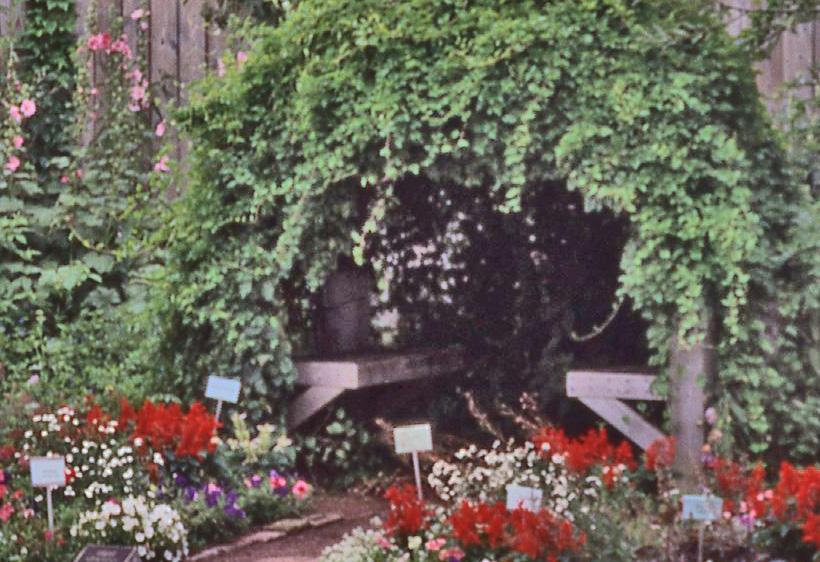
7 minute read
Child's Play by Bobbie Schwartz
A child-sized arch leading into an enclosed area at the Children’s Garden in the Cleveland Botanical Gardens.
The child-sized chairs echo the aesthetic of the adult chair.


The purplish-pink flowers of Dolichos lablab (Hyacinth Bean) are lovely and multitudinous but so will be the purple beans. There are a variety of books that address the topic of creating gardens for children. However, lot sizes are diminishing, making it increasingly difficult to set aside space specifically dedicated to playtime. In addition, the landscape needs to evolve as children grow and mature while also giving your clients room to enjoy themselves. The following suggestions can help you create spaces that stimulate children’s imagination while giving parents a grown-up place to relax.
Creating Comfort
Incorporating an arch or arbor into a landscape can add a touch of elegance as well as a focal point. Most of these structures, however, are at least six feet tall. Although great for adult guests, the size of these features can sometimes make small children feel uncomfortable. Why not create a secondary path that leads through a smaller archway? Such a feature can make children feel special and still maintain adult space.
Many homes today have decks or patios with seating for residents and guests. With this in mind, why not set aside a small area that includes seating and tables that are child-sized? The children will be more comfortable and thus better able to enjoy each other’s company.
If decks or patios are sited in bright sunlight, some shade or the illusion of shade can be provided by tepee-like poles or pergolas. Children would be more invested in the space if given the opportunity to help select which vines should grow up and across the poles. There are a variety of choices, ranging from Convolvulus annuus (Morning Glory) cultivars such as ‘Flying Saucer’ and ‘Tie Dye’ to Dolichos lablab (Hyacinth Bean) that has bright purple flowers and beans. Two other options include Phaseolus coccineus (Scarlet Runner Bean) and cherry tomatoes. Most of these plants can be used as a learning tool for children about food production.
Amazing Options
By incorporating features that both children and adults enjoy, landscape designers can create a garden that satisfies the needs of the entire family. Mazes are fun for visitors of all ages, and a wide variety of materials can be used to create them. If your clients are looking for a low, formal look, you might suggest planting Teucrium (Germander); or, if a meadowy appearance is desired, try ornamental grasses such as Miscanthus (Maiden Grass) or Panicum virgatum (Switch Grass). Even simpler and less maintenance would be a maze of hay bales.
The height of plant material used should depend on the ages and sizes of the children. Plants should be tall enough to impart a sense of adventure but not so tall that a child will become overwhelmed by fear. While kids will treat the maze as a quest, perhaps even purposely getting “lost”, adults often find it to be a meditative experience. If there is not enough space for a maze, turn a path into a tunnel with tall grasses or use a large Salix (Willow) on each side.
Sandboxes are the delight of children and the bane of parents. While children love to play with textures and move piles from one location to another, parents hate the dirt and grit and the necessity of a bath afterwards. An artist in Toronto constructed his child’s sandbox from concrete blocks, rimming it with brick and setting it into a patio and walkway. When the homeowners entertain, the sand is mounded into a conical sculpture. Should mess be a concern, it would be fairly easy to incorporate a childsized shower nearby. If well-designed, the shower can become a sculptural element in the landscape as well.
Playing House
Playhouses appeal to many children because most are usually scaled to their physical dimensions. I have seen some that are absolutely charming but expensive, built to order and painted lovely colors; some even have a flower garden roof. However, many of the prefabricated structures disfigure the landscape and leave nothing to the imagination. In fact, I specifically screened out the neighbor’s playhouse – a plastic log cabin with a screaming yellow and green roof and door.
Educators have long stressed that using imagination is crucial to developing a child’s thought process. Instead of giving kids a prebuilt playhouse, why not plant a weeping shrub or tree such Morus alba ‘Pendula’(Weeping Mulberry), Buddleia davidii (Butterfly Bush), or Salix caprea ‘Pendula’ (Weeping Pussy Willow) and place child-sized tables and chairs underneath? The area then becomes a playhouse, a private space and a tactile experience. Butterfly Bush is aptly named because it attracts a multitude of butterflies for all to enjoy; alternatively, Pussy Willow allows children to brush against the furry buds while adults can cut the stems for indoor arrangements.
Another possibility is the creation of a tepee densely covered with vines. Loofah (Luffa aegyptiaca), gourd-like vine, has large leaves and, of course, produces cucumber-like fruits that can be eaten or, if left on the plant to dry, can become sponges. However, I suggest Googling the steps necessary to effect this process. This hay bale maze is so short that even toddlers can enjoy it. If children are older, the height of the maze could be increased.


This raised bed was designed to be a sand pit initially. At a later time, it will be converted to a vegetable bed.

Toddlers can learn their colors with the seasonal plantings of the Rainbow Garden located in The Scotts Miracle-Gro Foundation Children’s Garden at Franklin Park Conservatory and Botanical Gardens.


A vine-covered arch make s a great hide-away for children. A variation on this theme is a “cave” I saw at River Farm in Alexandria, Virginia several years ago. The feature was built of wood and soil, and was placed under the branches of a Buddleia, providing a space for visitors to hide and climb.

Dream Time
Fear for their children’s safety has become such an issue that many parents are afraid to let their kids out of their sight these days. While understandable, this concern often results in children having very little privacy. With a little creative thinking and a touch of imagination, however, parents can give their kids a safe, private retreat in their own back yard. Consider building a makeshift bamboo fort for children. Although most bamboo can easily become a homeowner’s worst maintenance nightmare, this is not true of Fargesia nitida (Fountain Bamboo), a clumping bamboo. Using four of these plants as the corners and tying the tops on the diagonal, you could create an airy refuge for children.
Installing a small covered arbor with built-in seats that could be used for reading and dreaming, particularly if the seats have cushions covered in weather-resistant material, would be another way of providing children with a little privacy and shade.
Our children’s lives are so structured that we don’t leave them enough time for dreaming. Doing nothing is not a waste of time; it is an opportunity to think about one’s universe.
Sense and Sensibility
Adding interesting plant material can introduce a little childlike whimsy to the garden as well. Children are fascinated by textures, and a bold perennial grass like Arundo donax (Giant Reed) and one of the annual grasses like Pennisetum setaceum ‘Prince’ (Elephant Grass) look and feel like large cornstalks. For clients with small children, a grouping could be planted to a create a “jungle” for juvenile explorers while screening out a neighbor’s garage or an unsightly view. Don’t forget to supply child-sized pith helmets!
Soft, furry foliage is also appealing to children. Stacys byzantina (Lamb’s Ears), an easy-to-grow perennial that requires very little maintenance, has woolly, silver foliage that children love to touch. It grows best in hot, sunny dry sites that are frequently considered a challenge. Choose one of the cultivars, such as ‘Silver Carpet’ or ‘Big Ears’, that do not flower in order to cut



